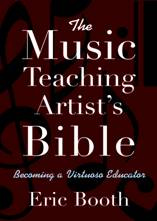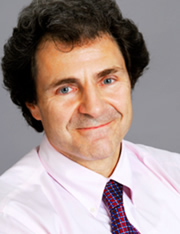Hockey has its Mr. Hockey®: Gordie Howe. 
Music has its Mr. Rock n Roll: Alan Freed.
Television has its Mr. Television: Milton Berle.
Arts Education has its Mr. Arts Education: Eric Booth.
Eric has really gone and done it now–he’s written what is essentially the big book of teaching artistry: The Music Teaching Artist’s Bible—Becoming a Virtuoso Educator
Click here to read more about and purchase it.
This was a great opportunity to pitch a few questions to my good friend Eric. Five questions plus a bonus question for good behavior:
EB: One of my goals has been to contribute to the building of the
profession of teaching artistry. We have come a long way. It has bothered me for
a long time that there is no foundation text about teaching artistry. We have an
increasing number of places for interested people to go to learn about TA-dom,
and what the work is like, but a book, as old tech as that rectangular thing is
is, still has a surprising legitimating power. My main purpose was to get a
first book out there, and I felt a respected mainstream publisher was
particularly important for bolstering our legitimacy. Second, I had an
old-fart’s impulse to pull together what I have learned through a lot of years
of insanely hard work and learning to save others the effort. I guess I am
trying to become a good ancestor. Frankly, I hate writing books, but I like
having written them. I also believed that if I/we could impress the publisher
with good sales, it would help establish the field as a legitimate market, and
more books would follow. In commercial America, this is an important step in
building a field. One of the compromises I had to make to get this out was to
use the lens of music in this book, when it is actually written for, and
applicabale to, all disciplines. 2. How long did it take and how would you
describe your particular process, from concept/genesis to published
form?
EB: Most
of the chapters are derived from the Edifications column I have written in
Chamber Music Magazine for a number of years; so a lot of the raw material was
there. Even at that, the writing, expanding, rewriting process took almost a
year, and the stuff that goes with completing a book, and getting it out into the
world took most of an additional year. All of this for royalties that probably
wouldn’t get me a quick long weekend trip to London.
come since you first started in this field?
EB: There
are several chapters on the history of TA-dom. I feel TAs were in pretty much
the “go into classrooms and create magic” role until the late ’80d/early ’90s.
Not a bad role, but one with more fairy dust than educative cohones. The
layering on of new responsibilities for TAs began with the standards movement,
and the assessment demands, and effective partnering, and facilitating, and
integrated curricular design work. We now have a spectrum of TAs, from those who
still prefer the older in-and-out, lower-commitment model, to deeply skilled
masters of this medium. Teaching artists who can deliver all the goods, right up
to working in a variety of settings and audiences, being effective advocates,
are among the most essential and inspiring humans I know. I think what master
TAs know and can do is exactly the elixir that can revive dessicated schooling
and transfuse relevance back into the arts for a majority of
Americans. 4. What are
some of the more advanced developments that teaching artists have made that
surprise you?
surprised anymore when they succeed, because I think the skills of a great TA
are so great, they can do anything. I am not surprised when TAs can take on a
corporate situation and deliver either a creativity training or even a
leadership training (as the TAs of the Memphis Symphony have recently done with
Federal Express). I am not surprised when TAs start and effectively run
organizations–Lincoln Center Institute, Big Thought, Urban Gateways, the Center
for Creative Aging, are run by TAs. You yourself Richard, have teaching artistry
in your genes. Jonathan Katz, who leads the National Assembly of State Arts
Agencies was a TA. I have been a little surprised that facilitation turns out to
be a skill in much demand for teaching artists professionally. The role of
Animateur at orchestras (mostly in Great Britain), which is basically a teaching
artist on staff, has surprised me–and America has had one too: Tom Cabaniss at
the Philadelphia Orchestra. I am surprised and delighted when teaching artists as entrepreneurs find a way to cash in on their skills–I created the
interactive curriculum for the Tiffany School of Manners in the early 80s, and I
have seen TAs create personal guidebooks for rich people’s private art
collections, and tourist touring of arts sites with TA guides. I think there is
real money out there for TAs who create a new generation of audio guides at
museums, for teaching artist tourism, for family workshops.
of arts education?
EB:One frontier is coordinating the
various strands of our work to have the sum equal more than the disparate parts.
In The Music Teaching Artist’s Bible, I propose a set of teaching guidelines
that try to start a conversation about what makes the teaching of teaching
artists distinctive. We are great at saying there are forty important things TAs
accomplish, and we are unable to say there are four key things TAs accomplish.
We can talk passionately for fifteen minutes or fifty minutes about teaching
artistry, and we suck at distilling it to two minutes. We are just not known up
enough as a field yet to have distilled and taken collective agreement about who
we are. We will never have complete agreement (I hope), but a step in a growning
field is knowing where the agreement lies and being able to present it
compellingly.
We don’t have effective integration of teaching artistry in the training of
artists, nor a proper infusion/introduction into the training of teachers or
arts administrators. There is a dearth of education directors at arts
institutions who understand and know how to make best use of teaching
artists.
practical front–health care, respectful pay, professional development that
works to draw and guide toward mastery. We don’t have effective ways to meet and
develop our own community. The Teaching Artist Journal, the Association of
Teaching Artists website, are good national entities; we have our first national
research underway (Teaching Artist Research Project); we have some foundations
working to build the field (the Dana Foundation in particular); we have local
entities in some cities. I believe that when the demand from TAs for more
community rises, the field will provide
ways.
really related to John Wilkes Booth?
EB: Let’s just say, the family prefers to
mention his brother Uncle Edwin Booth. But yes, Ogarita Booth was my granny’s
granny, and she was John’s daughter. Once when I did a show at the Kennedy
Center and then President Carter attended, the secret service put a guy on me
all night. He waited in the wings while I was onstage, and went to my dressing
room with me. You just can’t be too careful with these genes.





Thank heavens for Eric Booth! May this publication reach even more artists, musicians, educators, administrators, parents, funders and policy makers who have the power to influence arts in education.
Bravo!
Eric’s teachings are so right on for the times. We NEED creativity born of our yearnings to generate lasting improvements and markers of our time. How can I attend a class or lecture?
Thanks for posting this interesting interview and the link to his book.